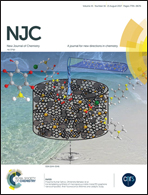Synthetic, spectral and structural studies of a Schiff base and its anticorrosive activity on mild steel in H2SO4†
Abstract
The Schiff base compound (E)-1,5-dimethyl-4-((4-methylbenzylidene)amino)-2-phenyl-1H-pyrazol-3(2H)-one (L) has been synthesized and characterized by elemental analysis, IR, NMR and single crystal X-ray diffraction techniques. The corrosion inhibition effect of the synthesized compound has been studied on mild steel in 0.5 M H2SO4, using potentiodynamic polarization and electrochemical impedance spectroscopy (EIS) methods. Polarization studies showed that L behaved as a mixed type (both cathodic and anodic) inhibitor and the inhibition efficiency (η%) increased with the increasing concentration of L, reaching the best inhibition of 99.87% at 0.1 mM L. The EIS results showed an increase in the charge transfer resistance with the increasing concentration of L. The inhibition action of the Schiff base molecule L is discussed in terms of blocking the electrode surface by means of adsorption of the inhibitor molecule obeying the Langmuir adsorption isotherm. Scanning electron microscopy (SEM) and atomic force microscopy (AFM) studies of the metal surface confirmed the existence of an adsorbed film. Quantum chemical calculations were undertaken to provide mechanistic insight into the mechanism of the inhibition action of L.



 Please wait while we load your content...
Please wait while we load your content...